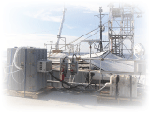Breakthrough in Measurement of Deposition of Ozone to the Ocean
August 8, 2006
 Scientists from NOAA Earth System Research Laboratories (ESRL, Ludovic Bariteau, Chris
Fairall, and Eric Williams) have collaborated with scientists from the University of
Colorado's Institute for Arctic and Alpine Research (INSTAAR, Detlef Helmig) to
perform the first direct ship-borne measurements of the flux of ozone from the
atmosphere to the ocean. In August 2006, the group is performing the first-ever
direct eddy correlation (EC) measurements of ozone flux from a ship (the NOAA
Research Vessel Ronald H. Brown) during the Texas Air Quality Study (TexAQS) in the
Houston area.
Scientists from NOAA Earth System Research Laboratories (ESRL, Ludovic Bariteau, Chris
Fairall, and Eric Williams) have collaborated with scientists from the University of
Colorado's Institute for Arctic and Alpine Research (INSTAAR, Detlef Helmig) to
perform the first direct ship-borne measurements of the flux of ozone from the
atmosphere to the ocean. In August 2006, the group is performing the first-ever
direct eddy correlation (EC) measurements of ozone flux from a ship (the NOAA
Research Vessel Ronald H. Brown) during the Texas Air Quality Study (TexAQS) in the
Houston area.
Background:
Near the surface, ozone is an important pollutant but, paradoxically, in the stratosphere
ozone protects against harmful UV radiation. It is also a greenhouse gas that can affect
the earth's climate by absorbing heat energy from the earth, then releasing it into the
atmosphere. While scientists have learned a great deal about how ozone is created and
destroyed in the atmosphere, there are still many missing pieces of the puzzle. Using a
new instrument designed and constructed in Boulder, our team of researchers are hoping to
find out more about destruction of ozone at the ocean surface. Because the oceans cover
about two-thirds of the earth's surface, they have a significant effect on feedbacks
between atmospheric ozone, other atmospheric pollutants, and the Earth's climate system.
The study area will be Texas and the northwestern Gulf of Mexico. The ozone flux breakthrough was made possible by recent advances in various aspects of EC measurement methods: realtime motion corrections of sonic anemometer signals (ESRL) combined with a new technology in fast ozone measurements (CU). Previously, the transfer rate of ozone into the ocean was estimated by assuming ozone transfer physics and chemistry were the same for all weather conditions and all bodies of water (small fresh lakes to large salty oceans).
Significance:
This TexAQS intensive field study will focus on providing a better understanding of the
sources and atmospheric processes responsible for the formation and distribution of ozone
and aerosols in the atmosphere and the influence that these species have on the radiative
forcing of climate regionally and globally, as well as, their impact on human health and
regional haze. These measurements are expected to provide new insights into the
parameterization of ozone deposition (loss) to the ocean and permit further development of
the NOAA COARE gas flux parameterizations for use in air quality and climate models.
(Photo: Ozone flux instrumentation aboard the R.V. Ronald H. Brown.)
| Contact: Chris Fairall | More Information: - Measuring Trace Gas Exchange Between Air & Sea - Gas Transfer Parameterizations (via FTP) |